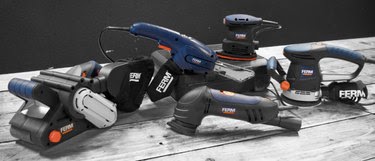Quck answer
Power sanders are versatile tools used for smoothing and shaping surfaces. There are several types of power sanders available, each designed for specific tasks.
1. Belt Sanders: Best for heavy-duty sanding and removing large amounts of material quickly. They are ideal for rough surfaces and woodworking projects.
2. Orbital Sanders: Ideal for fine finishing work and removing smaller amounts of material. They provide a smooth and swirl-free finish.
3. Random Orbital Sanders: Combines the benefits of belt and orbital sanders. They are versatile and suitable for both rough and fine sanding.
4. Detail Sanders: Perfect for sanding hard-to-reach areas and intricate designs. They are lightweight and maneuverable.
To use a power sander effectively, follow these steps:
1. Wear safety goggles and a dust mask to protect yourself from flying debris and dust.
2. Choose the appropriate sandpaper grit for your project. Start with a coarser grit to remove material and gradually move to finer grits for a smoother finish.
3. Securely attach the sandpaper to the sander according to the manufacturer’s instructions.
4. Hold the sander firmly and apply even pressure while moving it in the direction of the wood grain.
5. Keep the sander moving at all times to avoid creating uneven spots.
6. Avoid pressing too hard, as it may damage the surface or create gouges.
7. After sanding, clean the surface thoroughly to remove any dust or debris before applying finishes.
Remember to read the manufacturer’s instructions and take necessary safety precautions when using power sanders. With proper technique and the right sander, you can achieve professional-looking results on your woodworking projects.
If you engage in woodworking, the necessity of owning a sander becomes apparent. Power sanders are highly effective in smoothing wood surfaces and preparing them for finishing, although they can be used for various other purposes as well. These versatile tools can shape wood edges, eliminate minor obstructions preventing proper functionality of doors or drawers, and even roughen materials such as metal and epoxy to prepare them for painting.
Gone are the days of heavy, cumbersome belt sanders and corded orbital sanders that require both hands for operation. Modern sanders are lightweight, efficient, and cordless models are widely available. While the basic principle of wearing down wood with abrasive paper using electricity remains the same, today’s sanders are more user-friendly and suitable for a wider range of applications than their predecessors. While some models may be pricier than others, none will break the bank.
Comparing Orbital and Belt Sanders

Belt sanders and orbital sanders complement each other perfectly.
Image Credit:
Ferm
Although both belt sanders and orbital sanders are categorized as sanders, their purposes are entirely different. Belt sanders are primarily used for material removal, rather than achieving a polished wood finish – this is where orbital sanders come in. When you need to eliminate a surface coating or remove 1/8 inch or more of wood, a belt sander is the tool of choice. On the other hand, an orbital sander is ideal for erasing the scratches left behind by the belt sander and achieving a smooth finish.
The primary tasks for which a belt sander excels include:
- Rough flattening: Whether it’s a floor, stair tread, deck board, or the top of an old picnic table, a belt sander can level out the unevenness caused by warping.
- Rounding edges: When it comes to rounding the edges of table tops, shelves, and railings, a belt sander is the fastest tool for the job. Always sand with the wood grain to avoid cross-grain scratches.
- Stripping paint: Instead of dealing with messy paint strippers, a belt sander equipped with a coarse belt can efficiently remove paint.
- Fixing sticky doors: In the case of a door that fails to close completely, a belt sander can be used to shave off 1/8 inch from the edge.
Although some of these tasks can be accomplished with an orbital sander, it would take at least three times longer. The orbital sander, which moves the sandpaper in small circular motions instead of back and forth between two drums, provides easier control. It is recommended for the following jobs:
Wood Smoothing Techniques
- Smoothing wood: Before applying finish, it is essential for a woodworker to sand the piece using an orbital sander.
- Fine-tuning edges: To shape and give a smooth appearance to curved edges of flat woodwork, an orbital sander is used.
- Preparing old paint: Prior to applying fresh paint over existing paint, it is recommended to sand the old paint using an orbital sander to make it smooth.
Types of Orbital Sanders

There are two types of orbital sanders – orbital sanders and random orbital sanders. Orbital sanders have a square, rectangular, or triangular base that moves in a circular pattern, leaving scratches on the wood. On the other hand, random orbital sanders have a round base that also moves in a circular pattern, but with spinning motion. This spinning motion eliminates swirl marks left by orbital sanders, making it a more effective tool. Although random orbital sanders are harder to control, they are considered the best option for sanding.
Despite the superior sanding ability of random orbital sanders, many woodworkers prefer the ease of use of orbital sanders.
- Pad sanders are the smallest type of orbital sanders that fit in the palm of your hand and require a quarter sheet of standard sandpaper.
- Two-hand orbital sanders are lighter and more maneuverable compared to older models. They require a half sheet of sandpaper.
- Detail sanders are relatively new in the market and have a triangular base that can fit into tight corners. They are perfect for furniture refinishers and professional woodworkers. Some random orbital sanders also use a Velcro-like adhesive to connect the sandpaper to the base.
Battery-powered sanders have become popular among woodworkers due to their long-lasting batteries and portability. While sanding, it is recommended to wear a dust mask for protection.
Using a Power Sander

Regardless of the material being sanded, it is important to wear a dust mask and eye protection while using a power sander. To achieve great results, it is crucial to stay focused and follow best practices while sanding.
- Always sand in the direction of the wood grain. This is particularly important when using a belt sander, but it also ensures good results when sanding with an orbital sander. Scratches caused by sanding against the grain are almost always noticeable.
- Let the sander do the work. There is no need to apply excessive pressure to the sander. Doing so only makes it work harder and is the main reason why sanders sometimes create uneven surfaces. Apply enough pressure to stabilize the sander and save your energy for other tasks.
- Change the sandpaper frequently. If you find that your sanding job is taking longer than expected, it is likely because the sandpaper has worn out or become clogged. Regularly changing the sandpaper will ensure optimal performance from your power sander.
- Be gentle when sanding curves. Sanders, especially belt sanders, can alter the shape of a curve if too much pressure is applied. Maintain full control of the sander and consider lifting it slightly to avoid creating ridges or depressions.


